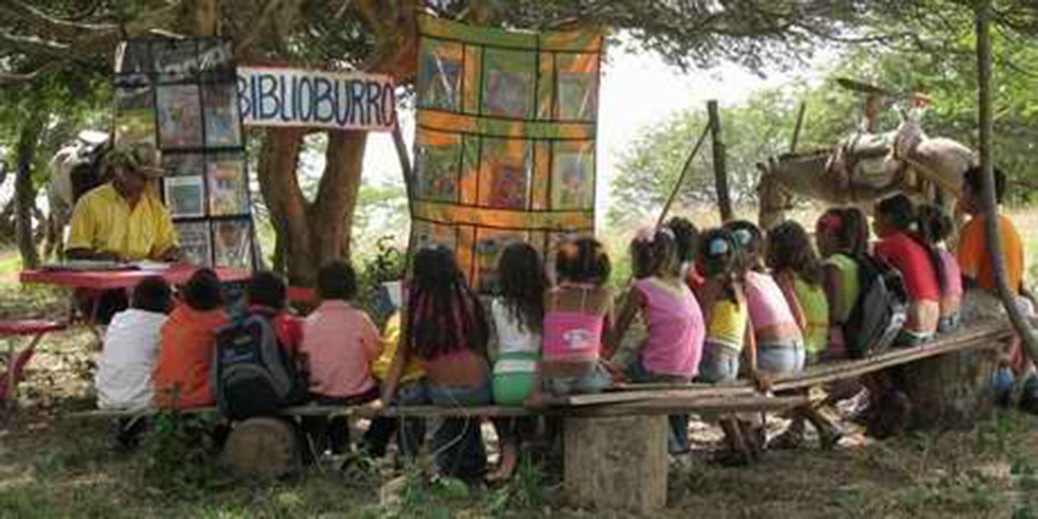 Religion and Spirituality CONTENTS: Foreword: Religion, Spirituality, Education and Social Justice: An Historical Perspective, Stuart Devenish and Martin Dowson. Series Introduction. Section I: World Religions. Justice in Islamic Spirituality: Implications for Individual Flourishing and Social Harmony, Bagher Ghobary Bonab. The Impact of Traditional Chinese Religions on the Social Justice Orientations of Chinese Christians, Denise Austin. The Contribution of Buddhism to Global and Regional Initiatives in Education, Trish Sherwood. Social Justice and Critical Thinking: The Contribution of Christian Perspectives on Education, Tony George. Section II: meaning, Motivation, and Maturity. Religion, Meaning, and Motivation, Martin L. Maehr. Ethical Decision Making: The Contribution of Religious and Spiritual Values, Maureen Miner and Martin Dowson. Counseling and Social Justice: The Role of Spirituality, Emotional Intelligence and Mature Racial Identity, Sachin Jain, Martin Dowson, and Alicia M. Lacouture. Section III: Teaching Policy and Practice. Multieligiosity in Singapore: Implications for Educational Policy and Practice, Ee Moi Kho, Min Fui Chee, and Giok Ling Ooi. Spirituality and Students’ Experiences in International Service Learning Courses, Valerie C. McKay & Natasha Gaffoglio. Religious Values in the History Classroom: Promoting Civic Competence, Tolerance, and Social Justice, Michael Lovorn and Shawn Proffitt. The Benefits of an Integrated Sacred-Secular Approach Youth Worker Training, Phil Daughtry. Section IV: Community Service and Development. The Critical Role of Black Religious Institutions in the Education of African Americans, Elinor L. Brown & Nadia C. Gadson. African Spirituality and Its Implications for Heath, Education, and Community Well-Being, Steve Edwards and Jabulani Thwala. Community Service Orientations of Indigenous Peoples: The Role of Spiritual Values, Bill Lawton.
Religion and Spirituality CONTENTS: Foreword: Religion, Spirituality, Education and Social Justice: An Historical Perspective, Stuart Devenish and Martin Dowson. Series Introduction. Section I: World Religions. Justice in Islamic Spirituality: Implications for Individual Flourishing and Social Harmony, Bagher Ghobary Bonab. The Impact of Traditional Chinese Religions on the Social Justice Orientations of Chinese Christians, Denise Austin. The Contribution of Buddhism to Global and Regional Initiatives in Education, Trish Sherwood. Social Justice and Critical Thinking: The Contribution of Christian Perspectives on Education, Tony George. Section II: meaning, Motivation, and Maturity. Religion, Meaning, and Motivation, Martin L. Maehr. Ethical Decision Making: The Contribution of Religious and Spiritual Values, Maureen Miner and Martin Dowson. Counseling and Social Justice: The Role of Spirituality, Emotional Intelligence and Mature Racial Identity, Sachin Jain, Martin Dowson, and Alicia M. Lacouture. Section III: Teaching Policy and Practice. Multieligiosity in Singapore: Implications for Educational Policy and Practice, Ee Moi Kho, Min Fui Chee, and Giok Ling Ooi. Spirituality and Students’ Experiences in International Service Learning Courses, Valerie C. McKay & Natasha Gaffoglio. Religious Values in the History Classroom: Promoting Civic Competence, Tolerance, and Social Justice, Michael Lovorn and Shawn Proffitt. The Benefits of an Integrated Sacred-Secular Approach Youth Worker Training, Phil Daughtry. Section IV: Community Service and Development. The Critical Role of Black Religious Institutions in the Education of African Americans, Elinor L. Brown & Nadia C. Gadson. African Spirituality and Its Implications for Heath, Education, and Community Well-Being, Steve Edwards and Jabulani Thwala. Community Service Orientations of Indigenous Peoples: The Role of Spiritual Values, Bill Lawton.

Ethnicity & Race (2011) Brown, E. L. and Gibbons, P. (Eds.). CONTENTS: Foreword, Christine Sleeter. Introduction: Ethnicity and Race—Creating Educational Opportunities for Equity and Social Justice Around the Globe, Elinor L. Brown and Pamela E. Gibbons. Section I: Influence of Policies on Racial and Ethnic Education. Educational Policy Toward Minorities in Russia: History and Modernity—The Case of Kalmyk Education, Liubov Chetyrova. American Public Education: Gatekeeper and Broker of Social, Political, and Economic Dominance, Elinor L. Brown and John J. Harris. Changing Attainment of Higher Education Among China’s Ethnicities: Comparison of 1990 and 2000 National Census Data, Stephen Bahry. The Politics of Charter School Diversity, Wayne D. Lewis. Section II: Higher Education Training for Racial and Ethnic Social Justice. Pop Culture: An Instructional Strategy for Cross-Cultural Training in Medical Education, Madison Gates, Elinor L. Brown, and Pangela Dawson. Three-Dimensional Representations of Social Work Students’ Identity: A Mixed-Method Analysis in a Multicultural Population, Julie Cwikel and Ephrat Huss. Friends, Whanau, and Students: Their Perceptions of and Contributions to the Academic Experiences of Maori and Pacific Island (Pasifika) University Students in New Zealand, Camille Nakhid. Section III: International Technology Initiatives that Nurture Multiethnic Unity and Social Justice. Bringing Higher Education to Displaced Ethnic Minorities on the Thai-Burma Border: Three Academic Models for Overcoming International, Ethnic, and Technological Barriers, Susan Costello, Marie Joyce, Michael Smith, S. J. Duncan MacLaren, and Thein Naing. A Case for the Use of Collaborative Tools for Research, Development, and Professional Service, Azra Naseem, and Susan Crichton. Accessible, Appropriate, and Effective Education: The Case of Nettel@Africa, Mark Beattie. Section IV: Community and Global Citizenship for Ethnic and Racial Social Justice. Freedom From Exploitative Child Labor Practices in East Africa: Strategies and Complications, Vachel Miller. Debney Park: Politics and Practices Amid Changing Ethnic Diversity in One Australian Secondary School, Madeleine M. Laming. Seeing Color: Diversity as a Palette for Teaching, Elite Ben-Yosef. Global Citizenship Education: Learning to be Part of a World Community, Ron Israel, Vachel Miller, and Susan F. Reed.
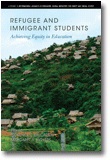 Refugee and Immigrant Students (2012) McCarthy F. E., Vickers. M. H. (Eds.). CONTENTS: Acknowledgements. Foreword: For My Grandparents, Carlos E. Cortés. Introduction: Education for Immigrants and Refugees: Creating Equitable Pathways for the Futures, Florence E. McCarthy and Margaret H. Vickers. Section I: Pedagogical Initiatives Addressing Issues of Educational Equity for Immigrants and Refugees. Positioning Refugee Students as Intellectual Class Members, Karen Dooley. Creating Shared Learning Spaces: An Intercultural, Multilingual Early Learning Program for Preschool Children from Refugee Families, Anna Kirova. Refugees as Educators: The Potential for Positive Impact on Educational Systems, Susan Banki. Identity and Inclusion: Education in Refugee Camps in Thailand, Su-Ann Oh. Section II: Refugee and Immigrant School-Community Partnerships. Children and Youth, Marian J. Rossiter and Tracey M. Derwing. Serving the Needs of Refugee Children and Families through a Culturally Appropriate Liaison Service, J. Lynn McBrien and Jillian Ford. Schools at the Crossroads of Competing Expectations, Linda Silka. Section III: Systemic Issues and Policies for Refugee and Immigrant Educational Equity. Australia’s New Arrivals Policy and the Need to Reform Refugee Education Provision, Florence E. McCarthy and Margaret H. Vickers. Equity in Education for Migrant and Refugee Children: Issues from the United Kingdom, Jill Rutter. Post-Primary Education Dilemmas in Protracted Refugee Situations, Timothy Brown. Learning from the Education Programs for Sri Lankan Refugee Students in India, K. C. Saha.
Refugee and Immigrant Students (2012) McCarthy F. E., Vickers. M. H. (Eds.). CONTENTS: Acknowledgements. Foreword: For My Grandparents, Carlos E. Cortés. Introduction: Education for Immigrants and Refugees: Creating Equitable Pathways for the Futures, Florence E. McCarthy and Margaret H. Vickers. Section I: Pedagogical Initiatives Addressing Issues of Educational Equity for Immigrants and Refugees. Positioning Refugee Students as Intellectual Class Members, Karen Dooley. Creating Shared Learning Spaces: An Intercultural, Multilingual Early Learning Program for Preschool Children from Refugee Families, Anna Kirova. Refugees as Educators: The Potential for Positive Impact on Educational Systems, Susan Banki. Identity and Inclusion: Education in Refugee Camps in Thailand, Su-Ann Oh. Section II: Refugee and Immigrant School-Community Partnerships. Children and Youth, Marian J. Rossiter and Tracey M. Derwing. Serving the Needs of Refugee Children and Families through a Culturally Appropriate Liaison Service, J. Lynn McBrien and Jillian Ford. Schools at the Crossroads of Competing Expectations, Linda Silka. Section III: Systemic Issues and Policies for Refugee and Immigrant Educational Equity. Australia’s New Arrivals Policy and the Need to Reform Refugee Education Provision, Florence E. McCarthy and Margaret H. Vickers. Equity in Education for Migrant and Refugee Children: Issues from the United Kingdom, Jill Rutter. Post-Primary Education Dilemmas in Protracted Refugee Situations, Timothy Brown. Learning from the Education Programs for Sri Lankan Refugee Students in India, K. C. Saha.
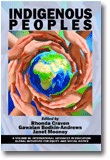
Indigenous Peoples (2013) Craven, R. G., Bodkin-Andrews, G., and Mooney, J. (Eds.). CONTENTS: Foreword, Joel Spring. Series Editors’ Introduction: Volume: Indigenous Peoples, Elinor L. Brown, Rhonda Craven, and George F. McLean. Volume Editors’ Introduction, Rhonda Craven and Janet Mooney. Indigenous Ainu and Education in Japan: Social Justice and Culturally Responsive Schooling, Kaori H. Okano. History, Cultural Uplifting, and Educational Policy of Taiwan’s Indigenous People, Karen Liu and Li Tsung-Wen Kuo. Indigenous Education in the Twenty-First Century in the Midst of Migration and Globalization: An Ecuadorian Case, Live Danbolt Drange. “Not an Educational Institution”: Native American Boarding Schools in the 19th and 20th Centuries, Annie T. Oakes. Section II: De/Colonization and Indigenous Knowledge. Indigenous Education in Greenland: Effective Pedagogy and the Struggles of Decolonization, Karl Kristian Olsen and Roland G. Tharp. Educating Indians: A Colonizing Agent of the United States of America, Neyooxet Greymorning. Culturally Responsive Education for Indigenous Communities, Jon Reyhner and Navin Kumar Singh. The Educational Travels of Tibetan Knowledge: The Intellectual Enfranchisement of Indigenous Peoples, Michael Singh and Qi Jing. Section III: Teachers, Students, and Pedagogies. Identifying the Fairy Dust Effect for Indigenous Australian Students: Is Positive Psychology Truly a [Peter] Pan Theory? Gawaian Bodkin-Andrews, Nida Denson, Linda Finger, and Rhonda Craven. Indigenous Motivational Profiles: Do They Refl ect Collectivism? A Cross-Cultural Analysis of Similarities and Differences Between Groups Classifi ed as Individualist and Collectivist Cultures, Dennis M. McInerney and Jinnat Alid. Discursive Repositioning in Te Kotahitanga: Supporting Teachers to Improve the Educational Experiences of Mãori Students in New Zealand, Mere Berryman and Russell Bishop. “Being Who I Am All the Days of the Week”: Indigenous Teachers and Indigenous Education: Sami Teachers in North Sweden, Jill Brown and Karolina Parding. Images of Cultural Identities: Sámi Children’s Experiences of Learning, Eva Alerby, Krister Hertting, Gunnar Jonsson, and Carina Sarri.

Communication and Language (2012), Yeung, A. S., Brown, E. L., Lee, F. K., (Eds.). CONTENTS: Foreword, Lourdes Diaz Soto. Series Introduction: Communication and Language, Elinor L. Brown, Rhonda C. Craven, George McLean. Volume Introduction, Elinor L. Brown and George McLean. Section I: Dominant or Traditional: Which Language to Use? Local Language of Instruction for Quality Learning and Social Equity in Tanzania, Zehlia Babaci-Wilhite. Linguistic and Social Equity for Yughur and Kyrgyz National Minorities in Northwest China: Disadvantages of Either–Or Choice Between Dominant-Language Submersion and Mother Tongue Education, Stephen A. Bahry and Rakhat Zholdoshalieva. Private Language Management in Singapore: Which Language to Practice and How, Xiao Lan Curdt-Christiansen. The Voice of the African Traditional Healer: Implications for Cross Cultural Educational Practices, Lynne Radomsky and Lisa Lopez Levers. Section II: Language Integration for Social Justice Empowerment. Language, Culture, and Communication: A Review of the Challenges Facing NESB Migrants in New Zealand, Mingsheng Li. Chinglish: An Interlanguage with Inherent Communicative Challenges for Chinese English Language Learners, Pierre Orelus and Wenjie Wang. Social Justice Education in the Language Classroom and Beyond, Nicole Benson. Section III: promoting Engagement Through Non-Verbal Communication Creating Language in a Vacuum: Deaf Children as Creative Communicators, Barbara Gerner de García. Auto-Photography and Captioning: Nonverbal Communication Tools, Elinor L. Brown. Art as Language, Pedagogy, and Method: Promoting Learning Engagement for Young African Refugee Migrant Students in Urban Australia, Felicity McArdle and Jennifer Pei-Ling Tan. Modes of Representation as Meanings for Second-Language Learners in Hong Kong, Tat Heung Choi. Section IV: Cross-cultural Communication: Removing Barriers to Educational Equity? Immigrant Students: Barriers and Facilitators to Understanding in a New Socio-Linguistic Setting, Karen Nicholas, Jo Fletcher, and Faye Parkhill. Teaching ELLs in the USA: Toward a Pedagogy of Social Justice and Empowerment, Davi S. Reis and Lisa Lopez Levers. Epistemic Justice and the Communication of Non-Western Theoretical Tools: Advancing the Internationalization of Research Education, Michael Singh and Guihua Cui. The Pragmatics of Non-Compliance by Tertiary Cantonese Learners of English, Cynthia Lee. Section V: Communication Proficiency and the Self. Self-Concepts of Englishspeaking and Non-English-Speaking Students in an English-Speaking Country, Alexander Seeshing Yeung. A Dual Disadvantage? Examining the Academic Self-Concept of Students with Learning Difficulties, Danielle Tracey.

Migrants and Refugees (2013), Brown, E. L., Krasteva, A., (Eds.). CONTENTS: Foreword, Francisco Rios. Volume Introduction, Elinor L. Brown. Section I: Educational Integration of Asylum-Seeking, Refugee, & Undocumented Children in Industrialized Nations. Integrating the Most Vulnerable: Educating Refugee Children in the European Union, Anna Krasteva. Educational Challenges Raised By Refugee and Asylum-Seeking Children and Other Newcomers: The Dutch Response, David Ingleby, Sander Kramer, and Michael S. Merry. Educating the Children of Undocumented Immigrant Parents: The Impact of Trauma on Citizen Children’s Development in the US, Lisa Lopez Levers and Rae Mancilla. Educational Integration of Asylum-seeking and Refugee Children in Sweden, Monica Eklund, Sara Högdin, and Ingegerd Rydin. Schooling on the Move: Refugee and Asylum Seeking Children in the Public School System of Bulgaria, Mila Mancheva. Section II: Creating A Pedagogy of Harmony for Displaced Populations. How the School Culture of Harmony Promotes Educational Equity for the Disenfranchised Migrant Children: An “Invisible Population” in China, Guangyu Tan. A Humanistic Pedagogy: Rethinking Education for Migrant and Refugee Students in Israel, Elite Ben-Yosef and Amira Yahalom. Problems and Possibilities: Equitable Education for Australian Refugee and Immigrant Youth and their Families, Carol Reid and Robert Mulas. Welcoming and Engaging Latino/a Immigrant Families: Improving Student Success, Janet Clark. Section III: Nurturing School Success: Acknowledging Cultural Traditions of Immigrant Students. Hong Kong’s Ethnic and Linguistic Minority Immigrant Students: An Evaluation of Educational Support Measures, Jan Connelly, Jan Gube, and Chura Bahadur Thapa. Fostering African Immigrant Students’ Social and Civic Integration: Unpacking their Ethnic Distinctiveness, Omiunota N. Ukpokodu. “I Want Dual”: Transnational Identity Among Filipino Immigrant Youth, Jeom Ja Yeo. Caribbean Immigrant Students: Funds of Knowledge and Possibilities for Successful Academic Performance, Janice B. Fournillier, Cheryl A. McLean, and June M. George. Section IV: Community Organizing: Forging Pathways to Educational Equity. Influence of Trauma and Status on the Education and Wellbeing of Undocumented Mexican Youth in the U.S., Elinor L. Brown and Debra Hyatt-Burkhart. Community Service Learning Track in Community Development and Organization in Kakuma Refugee Camp, Kenya, Lazarina Topuzova and Elizabeth Lock. Hear Our Voices! Youth and Community Leaders Creating New Paradigms for Social Change in Their Schools and Neighbourhoods, Rosemarie Hunter, David Alberto, Quijada Cerecer, Kimberly Schmit, Joel Arvizo-Zavala, Caitlin Cahill, Trinh Mai, and Sarah Munro.
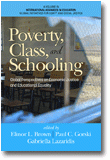
Poverty, Class, and Schooling (2014), Brown, E. L., Gorski, P. C., Lazardis, G., (Eds.). CONTENTS: Foreword–William A. Howe. Series Introduction—Elinor L. Brown, Rhonda G. Craven, and George C. McLean. Volume Introduction—Poverty, Class, and Schooling: Global Perspectives on Economic Justice and Educational Equity, Elinor L. Brown, Paul Gorski, and Gabriella Lazaridis. Section I: The Politics of Poverty in Education. Human Rights in Development Aid: Nordic Case for Education in Tanzania, Zehlia Babaci-Wilhite and Macleans A. Geo-JaJa. Poverty and Education in Crisis: Europe After the Failure of the Lisbon Strategy, Giovanna Campani. Is Educational Equality Possible?: Poverty and Education in India, Imandeep Kaur Grewal. Perceiving the Problem of Poverty and Schooling in the United States: Deconstructing the Class Stereotypes That Mis-Shape Education Practice and Policy, Paul C. Gorski. Section II: Economic Empowerment Through Retraining, Recognition, and Acceptance. Rising Urban Poverty and Class Discrimination Against Migrant Workers in China, Guangyu Tan. Migrant Education and Employment Equity in Slovenia: Officially Coveted, Factually Negated, Veronika Bajt and Mojca Pajnik. Challenges to Recognizing Foreign Competence for Employment in Finland: Avoiding Immigrant Economic Stratification, Johanna Lasonen and Marianne Teräs. Emerging From the Shadows: Countering the Marginalization of Indian Women in Rural Development and Education Programs, Supriya Baily. Section III: Equity Through Access to Higher Education. Impact of the National Scholarship Test on Equity in Higher Education in Kyrgyzstan, Duishon Shamatov, Abakir Mamytov, and Sabyr Iptarov. Access to Higher Education in Post-Socialist Countries: The Stories of Corruption, Standardization, Success, and Failure, Mariam Orkodashvili. PROUNI in Brazil: Advancement for Social and Economic Justice? Stella Maria Peixoto de Azevedo Pedrosa, Valéria de Figueiredo-da-Costa, Olivieri de Lima, and Nizia da Fonseca Ribeiro. Clemente Australia—Community-Embedded, Socially Supported University Education: Enhancing the Lives and Learning of the Socially Isolated, Peter Howard and Jude Butcher. Section IV: Education for Economic and Social Well-Being. Racialized Poverty and the Promise of Schooling: Te Search for Equitable Educational Outcomes for Aboriginal Peoples in Saskatchewan, Canada., Michael Cottrell and Paul Orlowski. Education in Ukrainian Orphanages: Hidden Curriculum for Social Reproduction or Transformation? Alla Korzh. Promoting Class Equity and Socioeconomic Justice for Children From “Communities of Promise”, David Zyngier. The Intersection of Poverty and Education in Haiti: A Case Analysis, Steve Sider and Gaëtane Jean-Marie. Poverty and Class Bias in Schools: An Anti-Classist Agenda for Educators, Terezia Zoric.
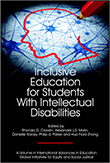 Inclusive Education for Students with Intellectual Disabilities (2015): Craven, R.G., Morin, A.J., Parker, P.D., Tracey, D., Zhong, H.F. (Eds) CONTENTS: Foreword, Christophe Maïano. Series Introduction, Elinor L. Brown, Rhonda G. Craven, and George F. McLean. Volume Introduction, Rhonda G. Craven, Alexandre J. S. Morin, Philip D. Parker, Danielle Tracey, and Hua Flora Zhong. Acknowledgements. Section I: Effective Transition Programs to Facilitate Future Success and Opportunities An Intensive Early Intervention Program: Building Inclusive Communities and Transitioning to Kindergarten, Claude L. Normand, Julie Ruel, and Lucie Leclair Arvisais. A Canadian Perspective on the Inclusion of Students With Intellectual Disabilities in High Schools, Tiffany L. Gallagher and Sheila Bennett. Starting With the End in Mind: Inclusive Education Designed to Prepare Students for Adult Life, Kathryn Best, LaRon A. Scott, and Colleen A. Thoma. Enhancing the Postschool Outcomes of Students With Intellectual Disabilities in Singapore: An Illustrative Example of Developing A Transition Program, Mee Choo Soh and Levan Lim. Section II: Pedagogy and Learning Environments that Enhance Social Justice and Educational Outcomes. Looking Back on the Inclusive Education Career of Three Young Adults With Intellectual Disabilities in the Flemish Speaking Part of Belgium: Becoming and Belonging, Geert Van Hove, Elisabeth De Schauwer, Inge Van de Putte. Inclusive Research and Learning Environments: Ideas and Suggestions for Inclusive Research and the Development Of Supportive Learning Environments for Children With Autism and Intellectual Disabilities, Eija Kärnä. Experiences of Learning: Students With Intellectual Disabilities in Higher Education in Ireland, John Kubiak and Michael Shevlin. Section III: Enabling Self-Determination and Authentic Participation in Decision-Making. Including Students with Intellectual Disability in Decision Making and Future Planning During and After Upper-Secondary Education—A Finnish Case Study, Aino Äikäs. Self-Determination and Inclusive Education for Students With Intellectual Disability, Karrie A. Shogren and Michael L. Wehmeyer. The Next Frontier—Advancing Quality of Life and Self-Determination by Explicating the Self-Concepts of Children With Mild Intellectual Disabilities, Danielle Tracey, Rhonda G. Craven, and Herb Marsh. Section IV: The Agency of Parents and Educators as Advocates for the Inclusive Education of Stunts with Intellectual disabilities. Parent Advocacy for Inclusive Education in the United States, Meghan M. Burke. Special Education Teachers of Children With Intellectual and Developmental Disabilities, and Teachers in Inclusive and Regular Classrooms—Differential Views Toward Inclusive Education, Frances Lai Mui Lee, Alexander Seeshing Yeung, Danielle Tracey, Katrina Barker, and Jesmond C. M. Fan. Parent’s Capabilities andInstitutional Conditions for Children With Intellectual Disabilities in Austrian Schools, Michaela Kramann and Gottfried Biewer. The Road to Inclusion for Children With Autistic Spectrum Disorder, Llyween Couper.
Inclusive Education for Students with Intellectual Disabilities (2015): Craven, R.G., Morin, A.J., Parker, P.D., Tracey, D., Zhong, H.F. (Eds) CONTENTS: Foreword, Christophe Maïano. Series Introduction, Elinor L. Brown, Rhonda G. Craven, and George F. McLean. Volume Introduction, Rhonda G. Craven, Alexandre J. S. Morin, Philip D. Parker, Danielle Tracey, and Hua Flora Zhong. Acknowledgements. Section I: Effective Transition Programs to Facilitate Future Success and Opportunities An Intensive Early Intervention Program: Building Inclusive Communities and Transitioning to Kindergarten, Claude L. Normand, Julie Ruel, and Lucie Leclair Arvisais. A Canadian Perspective on the Inclusion of Students With Intellectual Disabilities in High Schools, Tiffany L. Gallagher and Sheila Bennett. Starting With the End in Mind: Inclusive Education Designed to Prepare Students for Adult Life, Kathryn Best, LaRon A. Scott, and Colleen A. Thoma. Enhancing the Postschool Outcomes of Students With Intellectual Disabilities in Singapore: An Illustrative Example of Developing A Transition Program, Mee Choo Soh and Levan Lim. Section II: Pedagogy and Learning Environments that Enhance Social Justice and Educational Outcomes. Looking Back on the Inclusive Education Career of Three Young Adults With Intellectual Disabilities in the Flemish Speaking Part of Belgium: Becoming and Belonging, Geert Van Hove, Elisabeth De Schauwer, Inge Van de Putte. Inclusive Research and Learning Environments: Ideas and Suggestions for Inclusive Research and the Development Of Supportive Learning Environments for Children With Autism and Intellectual Disabilities, Eija Kärnä. Experiences of Learning: Students With Intellectual Disabilities in Higher Education in Ireland, John Kubiak and Michael Shevlin. Section III: Enabling Self-Determination and Authentic Participation in Decision-Making. Including Students with Intellectual Disability in Decision Making and Future Planning During and After Upper-Secondary Education—A Finnish Case Study, Aino Äikäs. Self-Determination and Inclusive Education for Students With Intellectual Disability, Karrie A. Shogren and Michael L. Wehmeyer. The Next Frontier—Advancing Quality of Life and Self-Determination by Explicating the Self-Concepts of Children With Mild Intellectual Disabilities, Danielle Tracey, Rhonda G. Craven, and Herb Marsh. Section IV: The Agency of Parents and Educators as Advocates for the Inclusive Education of Stunts with Intellectual disabilities. Parent Advocacy for Inclusive Education in the United States, Meghan M. Burke. Special Education Teachers of Children With Intellectual and Developmental Disabilities, and Teachers in Inclusive and Regular Classrooms—Differential Views Toward Inclusive Education, Frances Lai Mui Lee, Alexander Seeshing Yeung, Danielle Tracey, Katrina Barker, and Jesmond C. M. Fan. Parent’s Capabilities andInstitutional Conditions for Children With Intellectual Disabilities in Austrian Schools, Michaela Kramann and Gottfried Biewer. The Road to Inclusion for Children With Autistic Spectrum Disorder, Llyween Couper.

